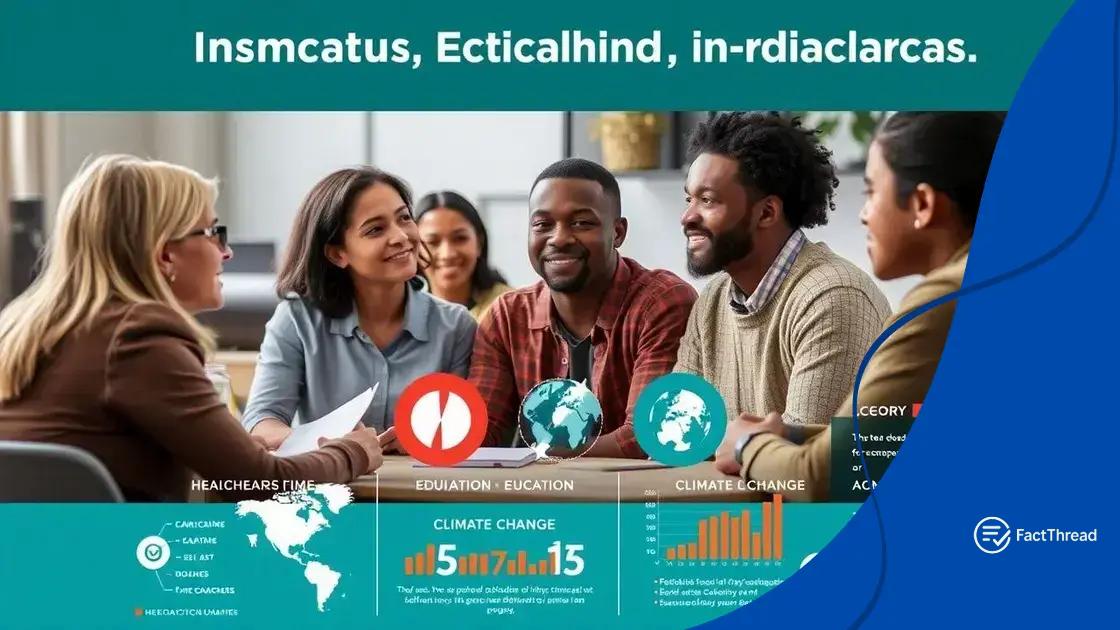Public opinion polls on key policy issues released

Public opinion polling captures citizens’ sentiments on key issues, influencing policy decisions and campaign strategies while evolving with technology and ensuring diverse representation.
Public opinion polls on key policy issues have become essential tools for understanding the pulse of the populace. Have you ever wondered how these insights shape political discourse? Let’s dive into the latest findings and their implications.
Understanding public opinion polls
Understanding public opinion polls is crucial for grasping how society views various issues. These polls help assess the feelings and priorities of the public, giving us insight into trends and changes in sentiment.
The purpose of public opinion polls
Public opinion polls serve multiple functions. They gather data on what people think about specific policies or events. With this information, decision-makers and analysts can better understand the public’s needs.
Types of public opinion polls
Different types of polls focus on various aspects of public sentiment:
- Tracking polls: These monitor changes in public opinion over time.
- Benchmark polls: Conducted at the start of a campaign, they establish a baseline for future polling.
- Exit polls: Taken immediately after voters cast their ballots to predict election results.
Each type provides valuable insights that can influence policy decisions. Understanding the methodology behind these polls is also essential. While numbers can indicate public interest or concern over an issue, it’s crucial they are interpreted correctly.
Factors such as sample size and question wording can significantly affect the results. A properly conducted poll can offer a snapshot of public opinion, while poorly designed polls may give misleading data.
Importance of analyzing public opinion
Analyzing public opinion allows leaders to gauge support for their initiatives. When a policy aligns with the public’s views, it is more likely to succeed. Conversely, if there is widespread disapproval, adjustments may be necessary.
Understanding how opinions change can help predict future trends. For instance, shifts in support for certain policies can often predict election outcomes. Thus, being attuned to these changes can be advantageous for political strategists.
In summary, public opinion polls are a lens into the collective mindset of society. By analyzing these data points, we can better understand what drives public sentiment and how it may shape future policies.
Recent trends in citizen sentiments
Recent trends in citizen sentiments reveal critical insights into how people view the world around them. By examining these trends, we can understand the factors that influence public opinions on key issues.
Current hot topics
Several issues currently dominate public conversations. These topics consistently appear in polls and discussions:
- Climate change: Many citizens express strong concerns about environmental degradation.
- Healthcare: Access and affordability remain top priorities for voters.
- Economic inequality: Growing disparities in wealth are increasingly on the public’s radar.
As we analyze these trends, it is clear that sentiments are often shaped by recent events and global challenges. For instance, natural disasters frequently spark discussions about climate action, while economic downturns can heighten concerns about financial security.
Demographic shifts
Another significant factor impacting citizen sentiments is the changing demographics of the population. The preferences of younger voters, who typically prioritize social justice and equality, contrast sharply with those of older generations. This generational divide plays a crucial role in shaping policy discussions.
Furthermore, geographic location can influence sentiment trends. Urban residents may feel differently about public transportation and infrastructure than those living in rural areas. Understanding these regional differences can provide a clearer picture of what citizens value.
Media also plays a significant role in shaping public sentiment. With the rise of social media, information spreads rapidly, influencing opinions almost instantly. Citizens are more engaged than ever, sharing their thoughts and feelings online, leading to real-time shifts in public opinion.
In conclusion, monitoring recent trends in citizen sentiments is vital for understanding the broader picture of public opinion. By analyzing the factors that drive these sentiments, we can better anticipate future attitudes and the potential impact on policy and governance.
Key policy areas under scrutiny

Key policy areas under scrutiny reveal the major concerns of citizens today. These areas reflect the topics that resonate deeply with the public, impacting decisions at all levels of government.
Healthcare
The healthcare system is a top priority for many people. Citizens want to ensure they have access to affordable and quality care. With rising healthcare costs, many are advocating for reforms that would expand coverage and reduce expenses.
Education
Education is another vital area for public opinion. Parents and students alike are concerned about educational quality and accessibility. As debates about funding and curriculum continue, citizens are pushing for changes that will better serve the needs of all students.
Climate change
Climate change is increasingly at the forefront of public consciousness. Many feel that urgent action is needed to address environmental issues. Citizens often support policies that promote renewable energy, reduce carbon emissions, and protect natural resources.
- Renewable energy initiatives: There is strong backing for policies promoting wind and solar energy.
- Regulations on emissions: Many advocate for stricter regulations to limit pollution.
- Conservation efforts: Citizens often support efforts to conserve wildlife and natural habitats.
These key areas are not only important to individual citizens but also play a significant role in elections. Politicians often align their platforms with public sentiment on these issues to gain support.
Understanding which policies are under scrutiny can provide valuable insights into upcoming elections and legislative initiatives. The ability to respond effectively to these concerns is crucial for leaders aiming to maintain public trust.
Discussions around these policy areas often evolve rapidly, influenced by new information and events. Keeping track of public sentiment can ensure that policymakers are aware of changing priorities and expectations.
Impact of polls on policy decisions
The impact of polls on policy decisions cannot be overstated. Understanding public opinion is vital for elected officials and policymakers. Polls provide a snapshot of the electorate’s views, helping guide decisions on pressing issues.
Shaping policy agendas
When polls show strong support for specific issues, officials may prioritize these topics. For instance, if a poll reveals that healthcare reform is a top concern, lawmakers may focus on drafting new legislation to address those findings. This responsiveness can enhance public trust and engagement.
Influencing political strategy
Polls also influence political campaigns and strategies. Candidates often tailor their messages based on polling data to attract voters. By highlighting issues that resonate with constituents, they improve their chances of electoral success.
- Targeted messaging: Campaigns can craft messages that directly address voter concerns.
- Resource allocation: Campaign funds can be directed to areas where polls indicate stronger support.
- Debate preparation: Knowing public opinion helps candidates prepare for debates and media appearances.
Moreover, the continuous evolution of public opinion means policymakers must stay alert to shifting sentiments. This adaptability is crucial, as issues that were once a priority can quickly diminish in importance as new concerns arise.
Additionally, polls can serve as a feedback mechanism. After implementing new policies, officials often look to subsequent polls to gauge effectiveness and public approval. This approach ensures that policymakers remain connected to their constituents’ needs and preferences.
However, relying too heavily on polls can also lead to challenges. Decision-makers may avoid bold initiatives that are unpopular at the moment, ultimately stifling necessary progress. Striking the right balance between public opinion and decisive leadership is essential in crafting effective policy.
Future of public opinion polling
The future of public opinion polling is evolving rapidly. With advancements in technology and changing societal norms, polling methods are becoming increasingly sophisticated.
Integration of technology
Modern polling techniques now leverage advanced technology. Online surveys and mobile apps make it easier to reach a broader audience. This integration not only enhances data collection but also allows for real-time analysis of public sentiment.
Shifts in methodology
As voter demographics change, polling methodologies are adjusting too. Traditional phone interviews are declining, while online polls gain popularity. This shift reflects the preferences of younger voters who may favor digital engagement.
- Increased use of social media: Pollsters are turning to platforms like Twitter and Facebook to gauge public opinion.
- Data analytics: Using big data, analysts can track trends more effectively.
- AI and machine learning: These technologies can predict outcomes based on historical polling data.
Additionally, the role of transparency and accuracy becomes more paramount. With the rise of misinformation, credible polling organizations must demonstrate their methodologies clearly. This helps build public trust, ensuring that survey results are taken seriously.
Furthermore, engagement with diverse populations is vital. Future polls will need to ensure they are representative, capturing various viewpoints across different demographics. This inclusivity is essential for accurate reflections of public sentiment.
As political landscapes grow increasingly dynamic, the ability to adapt polling strategies in real-time will be crucial. Pollsters must remain responsive to emerging issues, adjusting their questions to reflect the current political climate.
FAQ – Frequently Asked Questions about Public Opinion Polling
What is the purpose of public opinion polling?
The purpose of public opinion polling is to gauge the sentiments of the public on various topics, helping policymakers understand what citizens care about.
How do technology advancements impact polling methods?
Technology advancements, like online surveys and mobile apps, have made it easier to reach a wider audience and analyze data in real-time.
Why is diversity in polling important?
Diversity in polling ensures all demographics are represented, capturing a more accurate picture of public opinion across different groups.
What role does transparency play in public opinion polls?
Transparency in polling is crucial for building trust; it helps the public understand how the data was collected and analyzed.